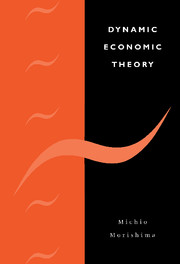Book contents
- Frontmatter
- Contents
- Preface
- 1 The method of dynamic analysis
- 2 Households' and firms' economic behaviour
- 3 Stability conditions for a temporary equilibrium: the linear case
- 4 Stability conditions for a temporary equilibrium: the non-linear case
- 5 Comparative dynamics
- Appendices
- Mathematical notes
- ADDENDUM
- Introduction
- Article I Walras' own theory of tatonnement [partly written in 1958]
- Article II Tatonnement in quantities: truncation, equilibration, growth [1956]
- Article III A contribution to the non-linear theory of the trade cycle [1958]
- Article IV Stability, oscillations and chaos
- Article V A generalization of the gross substitute system [1970]
- Article VI The laws of the working of the quasi-Frobenian system [1954, yet unpublished]
- Article VII The Cournot–Walras arbitrage, resource consuming exchange, and competitive equilibrium (with M. Majumdar) [1978]
- Article VIII The dilemma of durable goods
- References
- Index
Article I - Walras' own theory of tatonnement [partly written in 1958]
Published online by Cambridge University Press: 08 February 2010
- Frontmatter
- Contents
- Preface
- 1 The method of dynamic analysis
- 2 Households' and firms' economic behaviour
- 3 Stability conditions for a temporary equilibrium: the linear case
- 4 Stability conditions for a temporary equilibrium: the non-linear case
- 5 Comparative dynamics
- Appendices
- Mathematical notes
- ADDENDUM
- Introduction
- Article I Walras' own theory of tatonnement [partly written in 1958]
- Article II Tatonnement in quantities: truncation, equilibration, growth [1956]
- Article III A contribution to the non-linear theory of the trade cycle [1958]
- Article IV Stability, oscillations and chaos
- Article V A generalization of the gross substitute system [1970]
- Article VI The laws of the working of the quasi-Frobenian system [1954, yet unpublished]
- Article VII The Cournot–Walras arbitrage, resource consuming exchange, and competitive equilibrium (with M. Majumdar) [1978]
- Article VIII The dilemma of durable goods
- References
- Index
Summary
Introduction
It seems to be a generally supported view that the theory of stability has smoothly developed from Walras, through Hicks, to Samuelson who is the originator of the mathematical framework of contemporary stability theory. In terms of the terminology used in this volume, Samuelson concentrates his interest upon the stability of the equilibrium point, while Hicks' object is to deal with economic motion through weeks. Walras is nearer to Hicks than Samuelson in the sense that he is also concerned with economic motion or path rather than with a stationary or static point but differs from Hicks because the path examined is a sequence of temporary equilibria in the case of Hicks, while it is, as will be shown in section III below, a disequilibrium path in the case of Walras.
Arrow and Hahn, in their now classic work (1971, pp. 4–5), who regard Walras' stability theory or theory of tatonnement as ‘rather clumsy’, criticize it in the following way. Walras considers that the markets carry out tatonnement in some definite order. In the first market the price is adjusted so that supply and demand are equal, regarding other prices as given. This change in the price will affect supply and demand in all other markets.
- Type
- Chapter
- Information
- Dynamic Economic Theory , pp. 196 - 206Publisher: Cambridge University PressPrint publication year: 1996
- 1
- Cited by



